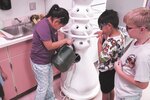Students from Mrs. Henderson’s third-grade class are sharing their classroom with dozens of new organisms after a visit from TerraBirds last August. The new classmates are vegetables and herbs …
This item is available in full to subscribers.
To continue reading, you will need to either log in to your subscriber account, below, or purchase a new subscription.
Please log in to continue |


Students from Mrs. Henderson’s third-grade class are sharing their classroom with dozens of new organisms after a visit from TerraBirds last August. The new classmates are vegetables and herbs growing in a tower in the back of the classroom.
TerraBirds is a non-profit organization from Flagstaff that provides schools and teachers with gardening programs.
The idea is to help students better understand how plants grow, whether in hydroponic arrangements in urban habitats or more traditional outdoor garden spaces and greenhouses, and encourage them to be good stewards, explained Nicole Houston, School Gardens Program Coordinator for TerraBirds.
Two TerraBirds representatives visited Mrs. Henderson’s class and helped the students build and install the grow tower, as well as plant the herbs and vegetables. The first part of the project is building the grow tower, which includes a large, sturdy base that holds the water and liquid nutrients, with four levels above it that hold the plants and grow lights. The grow tower comes in units that snap together.
Having students build the tower is an important part of the process, said Houston. “It’s a great STEM exercise, and it helps them establish ownership of the project. It’s very important for the kids to be involved with the construction of the tower, so they can understand how it works.”
Tier by tier Mrs. Henderson’s students added the levels and connected the cords that power the grow lights. They then mixed water with nutrients such as potassium, phosphorus and nitrogen, and when that part was complete, they snapped in grow pods. Each pod contains a different herb or vegetable.
At each stage of the project, the TerraBirds reps explained to the students how the grow lights work (they shine in the photosynthetic spectrum that plants like to grow in), how the nutrients feed the plants and how that also works in garden soil, and ways that farmers and gardeners add amendments to the soil, such as compost, to enrich it.
The students enjoyed being involved with the project.
One of those students was Carson Yazzie, who said his favorite part was building the tower, level by level. He said he loves watching the plants grow a little bigger every day. He hopes his class and school do more hands-on projects like this one.
Bentley Smith’s favorite part was filling the tower with water and nutrients, then snapping in the grow pods filled with seeds. He too enjoys watching the steady growth of the plants.
“I like that you can just bring the water in a can and fill it up (the grow tower) in here and it does the rest.”
Even after the grow tower is constructed and the lights and grow pods installed, students continue to play an active role, making sure the tower contains water and making sure the pH of the water is correct.
“The grow tower is a jumping-off point for the teacher to continue this type of education,” said Houston. “Most kids have never seen food grow. They’ve never watched lettuce grow.”
Studies show that kids who are involved in gardening projects are more likely to eat and enjoy vegetables and it opens the door for teachers to talk to their students about nutrition and healthy eating.
TerraBirds provides gardening programs to schools in Flagstaff, Page and the Grand Canyon area. They service 14 different schools. In Page, they have also done programs with Glen Canyon Outdoor Academy and Tse Yaato. They work in coordination with the Coconino County Education Agency in conjunction with an Early Childhood Education grant.
“One of the big goals is to educate and empower youth through gardening,” said Houston. “Nature is our oldest teacher and we are getting further and further away from it. It’s healthy for them, they learn to eat healthy foods, and encourages increased stewardship and involvement in their community.”